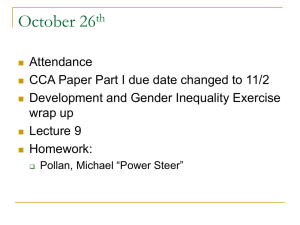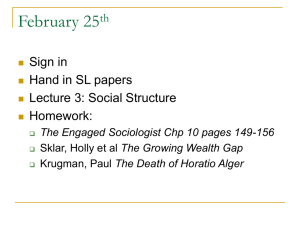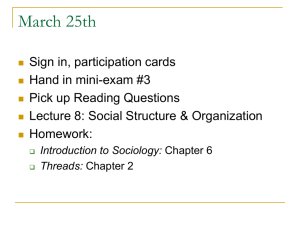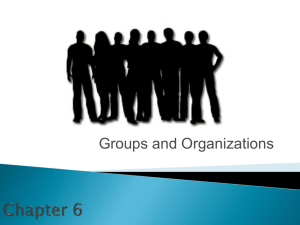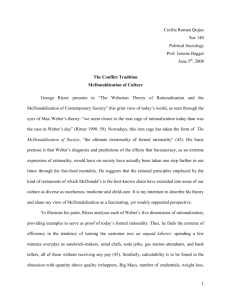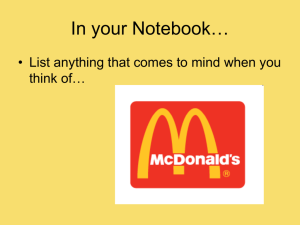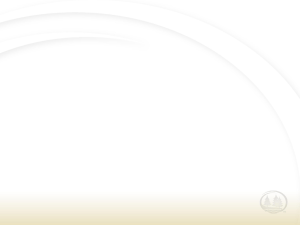Recap: Lecture Four
advertisement
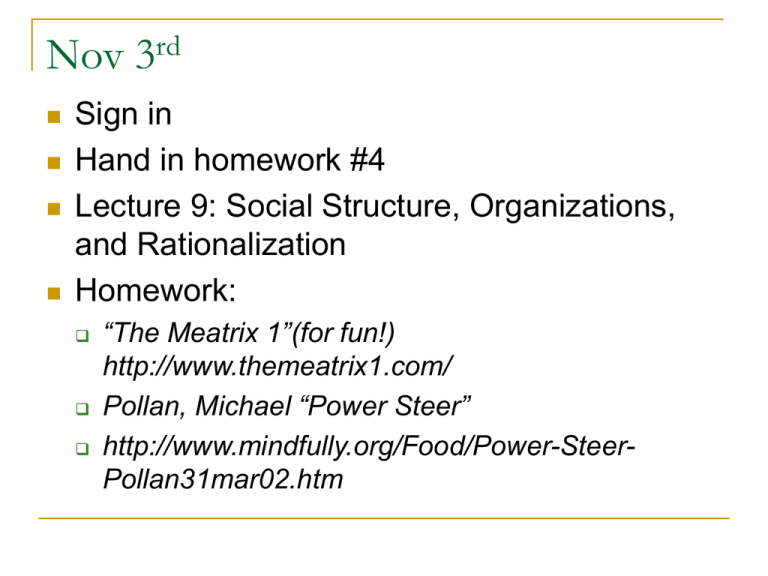
Nov rd 3 Sign in Hand in homework #4 Lecture 9: Social Structure, Organizations, and Rationalization Homework: “The Meatrix 1”(for fun!) http://www.themeatrix1.com/ Pollan, Michael “Power Steer” http://www.mindfully.org/Food/Power-SteerPollan31mar02.htm What did you consume today? Take ten minutes and write a list of the things that you consumed today (things you purchased and/or used). For these items try to list: How you got it and where The company responsible for bringing it you (best guess) EXAMPLE: Dasani tap water, Gav cafeteria, Coca Cola Corp. Lecture Nine Social Structure: Shaping the context of social interaction Context of Social Interaction Social Structure: Organized patterns of social relationships and Beliefs/Values social institutions Actions/ Behavior (Culture) Social Structure both reflects and reproduces our behavior and culture Social Structure Example: Fast Food Industry What changes made the fast food industry possible? Growing car culture in the US Industrialization of agriculture Economic boom and increasing disposable income What changes does the industry make possible in our lives? Fast past work environment Increase in dual income households Allows us to work harder and more hours 40% of our meals eaten outside of the home 1 in 4 Americans eats FF every day Rationalization Rationalization: process by which thought and action are no longer rooted in emotion, tradition, but become rooted in ‘value-rational’ thought and action Value –system (culture) Organizational structure The Cow Hindus – symbol of everything alive McDonalds – “means to an end” Social Groups As society becomes organized around rationality we shift social life from Primary groups Small, face-to-face, intimate, enduring sense of commitment Family To Secondary groups Large, impersonal with weak ties and short relationships Work & school Modern Organizations Bureaucracy: organization that uses the most efficient means to achieve a valued goal Clear division of labor Authority is hierarchical Formal rules and regulation Impersonality Power and responsibility lies in the position Office Space Corporations Corporation: legal form of public and capitalist organization in which control passes to a managerial group Organized rationally with the goal of maximizing profit A corporation is a social and legal creation that under US law is a legal person They can own property, sign contracts, go bankrupt, pay taxes, and enjoy some constitutional rights What did you consume today? Corporate Society Corporate Society: society in which large scale corporations organize and are involved in social, political decision-making process Secondary groups that organize our lives Globalization is bringing about a global corporate society Multinational Corporations: operate and coordinate production, distribution and consumption across national borders A New (Global) Rationality? McDonaldization: organizational principles of the fast food sector have come to dominate society Efficient Quantification Predictability Control thru non-human Technology Irrationality According to Ritzer, rational systems can lead to irrational outcomes "Most specifically, irrationality means that rational systems are unreasonable systems. By that I mean that they deny the basic humanity, the human reason, of the people who work within or are served by them." Disenchantment of the World Consumer culture at large works to eliminate genuine human interaction, because interactions are unpredictable and waste time As our interactions are structured by rational environments, there is a break down in genuine and spontaneous human interaction “How are you today?” Affects on Workers & Consumers Deskilling of labor: requires a work force with the minimum skills possible to complete simple focused tasks This means that they can be quickly and cheaply trained and are easily replaceable. Consumers became trained to think and act rationally turn consumers into workers Change our behavior and speech McDonaldization of Everything? Three Groups: #1 Hollywood Movies #2 Gavilan College #3 Suburban Housing Developments Designate one person to write for the group and put all names on the paper Explain Characteristics: Efficient Quantification Predictability Control thru Non-human Technology What are the positive and negative outcomes of McDonaldization in the area? “Iron Cage of Rationality” According to Weber, rationality can become a cage in which we are trapped and our basic humanity denied As society becomes more rational, people are locked into a series of rational systems, only able to move from one system to another from rationalized educational institutions, to rationalized workplaces, to rationalized recreational settings, to rationalized homes. Society would become a seamless web of rationalization from which there would be no escape Threads What changed in the organization of textile production? 1. Rationalization of the production process One person/one product → many people/one product What structural changes in society? $ and wage economy Work outside the home Technological changes How did the apparel industry become rationalized? Efficiency Quantification SAM’s (pg 31) Predictability Deskilling (pg 30) & Section work Standardized clothing Control Skill now equals speed, not craft What role does technology play? Quick Response & Information Technology (pg 41) Creates concentration without centralization Why did this encourage movement around the world? “Favorable business climate” Low wages, no unionization, cheap resources, subsidies “Cheap labor” based on gender and racial inequality Why did brands become important? Products become standardized, brands are needed to distinguish them What organizations play a primary role in the organization of the apparel industry? Corporations Government (trade rules)
